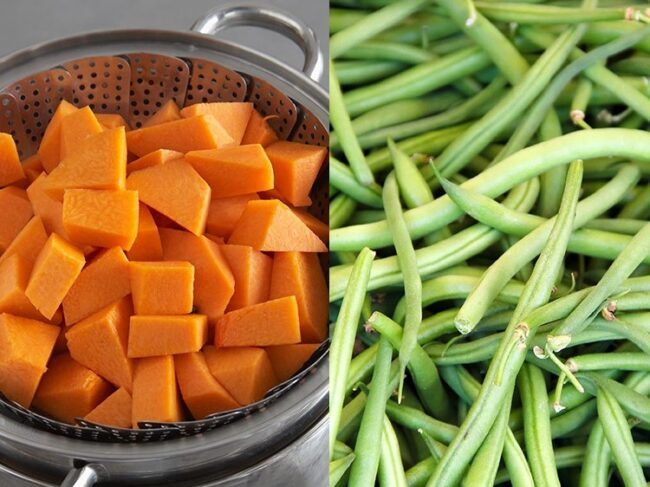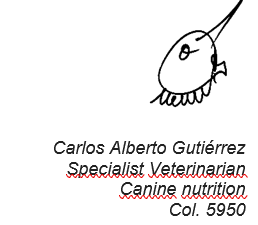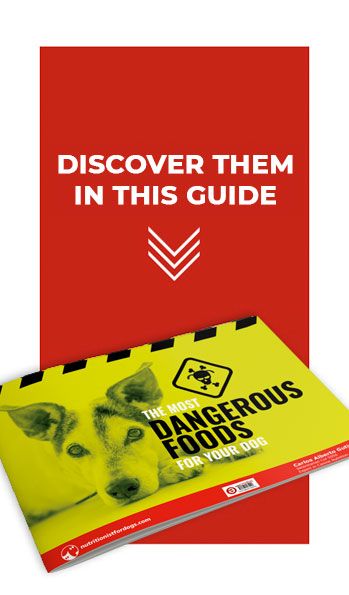
If you think dogs should only eat meat because they’re carnivores, you’ve got it all wrong. If that were the case, their diet would be incomplete.
You should understand that while the foundation of their diet is animal protein, for a truly healthy dog, they need foods from other groups too: carbohydrates, fats, vitamins, and minerals.
Therefore, fruits and vegetables should also be a part of their diet, in the right proportions and quantities. And what do they have in abundance, among other nutrients? FIBER, VITAMINS, and MINERALS.
Now, in this article, I’m going to focus on 2 specific veggies that you absolutely should include in your dog’s diet. They’re essential for maintaining your dog’s intestinal flora and colon health.
Why, you ask?
Because your dog’s intestinal flora feeds on prebiotics. A strong health foundation and a robust immune system start in the gut. To achieve this, having a high-quality gut flora is crucial. One of the requirements is to provide this gut flora with prebiotics, and vegetables provide high-quality prebiotics to nourish it.
Green beans – Why are they good?
Because of their high fiber content, they help improve digestion and regulate your dog’s intestinal function.
They contain vitamins A and C, among others, which help maintain a strong immune system. But more importantly, they have significant antioxidant properties that help control inflammation, slow down aging, and prevent various diseases in dogs.
Vitamin A is also essential for dental health and supports your dog’s eye and skin health.
Furthermore, they contain high levels of vitamin K, which helps keep your dog’s bones strong and healthy.
They’re low in calories, so if you have an overweight dog, they’re excellent to include in their diet. But don’t overdo it; you should know the right proportion and quantity to give them based on their weight and age.
Beware! Obesity can shorten your dog’s life by up to 2 years. So, besides preparing a suitable homemade natural diet with all your love, it’s essential that your dog gets some exercise.
Green beans also have plenty of Omega-3, which helps with your dog’s cardiovascular health.
A piece of advice: try to buy fresh or frozen green beans, not canned ones, as canned ones often contain a lot of salt.
Pumpkin – Can your dog eat it?
Not only can they eat it, they should eat it; and so should you.
Why, you ask?
Because of the countless nutrients and properties they contain, such as:
Vitamins A, C, and E, which are excellent for improving brain function, the immune system, skin health, and eye health.
Minerals like copper, potassium, iron, and manganese, which play a role in cellular functions.
Fiber, which helps your dog’s digestive health. If they have diarrhea, give them some pumpkin because it contains a lot of soluble fiber that absorbs water, which can help make their stools firmer.
For some of my digestive patients, not all of them, I include pumpkin powder in their diet.
And if your dog is constipated, pumpkin can help in the opposite way: because of its high fiber content, it can help loosen the stools.
Moreover, it helps prevent a common problem in dogs: anal gland blockage.
Pumpkin, like other orange vegetables, also helps with eye health due to the high amount of beta-carotene, a precursor to vitamin A, which improves vision, skin, fur, and overall immune health.
Antioxidants: they protect the body from free radicals, which are unstable molecules produced during normal cell metabolism (chemical changes that happen within a cell).
Free radicals can accumulate in cells and damage other molecules, like DNA, lipids, and proteins. This damage can increase the risk of cancer and other diseases in your dog.
Pumpkin’s antioxidants contain carotenoids (beta-carotene, beta-cryptoxanthin, zeaxanthin), which help reduce the risk of cancer and other degenerative diseases, and they also improve heart health.
It’s a natural dewormer: pumpkin seeds are low in fat and high in protein. They’re also a natural and effective way to get rid of parasites like digestive tract worms in your dog.
The seeds contain cucurbitin, which is an amino acid that paralyzes worms and, thus, helps eliminate intestinal worms. However, this doesn’t mean that if you give your dog pumpkin, they won’t get parasites. It’s best to do a coproparasitoscopic analysis. Consult your veterinarian.
How to prepare green beans and pumpkin for your dog
In general, many dogs, due to their carnivorous nature, don’t like vegetables. In the wild, they ate them mostly from the intestines of their prey. A good way to provide them is through protein and veggie mixes.
As for pumpkin, I recommend that you cook its flesh and include it in your dog’s diet in the right amount and proportions according to their weight and age. If you want to know how to do it, fill out the following questionnaire, and we’ll start working together:
The same goes for green beans: cook them well and add them to their meal.
For puppies, introducing veggies into their diet is straightforward, and they’ll eat them without any issues throughout their lives.
But if your dog is an adult and has never eaten veggies, it’s more challenging to get them to eat them. Here’s a trick: blend them and mix them with a few sardines from a can.
If your dog likes veggies on their own without any tricks, congratulations! Give them as treats, but remember, they’re only a SUPPLEMENT; it’s not their primary diet. Your dog isn’t a parrot!
Cooked vegetables: there’s nothing wrong with offering a raw carrot. If they eat it, great. But if you want them to receive the full benefit of it, I recommend boiling it as if it were for you.
Herbivores are designed to eat raw veggies, while carnivores ate them from the intestines of the prey they hunted, and these veggies had already undergone partial digestion. That’s why a carnivore benefits more from well-cooked veggies.
Conclusion:
A carnivore doesn’t just eat meat; doing so would lead to serious problems and nutritional deficiencies.
Including vegetables as a supplement in your dog’s diet is crucial for a healthy dog with a robust digestive system.
I hope this helps! If you have any more questions or need further assistance, feel free to ask.
If you want to work together with us, click here and fill out the questionnaire.
Yours in canine health,
Carlos


